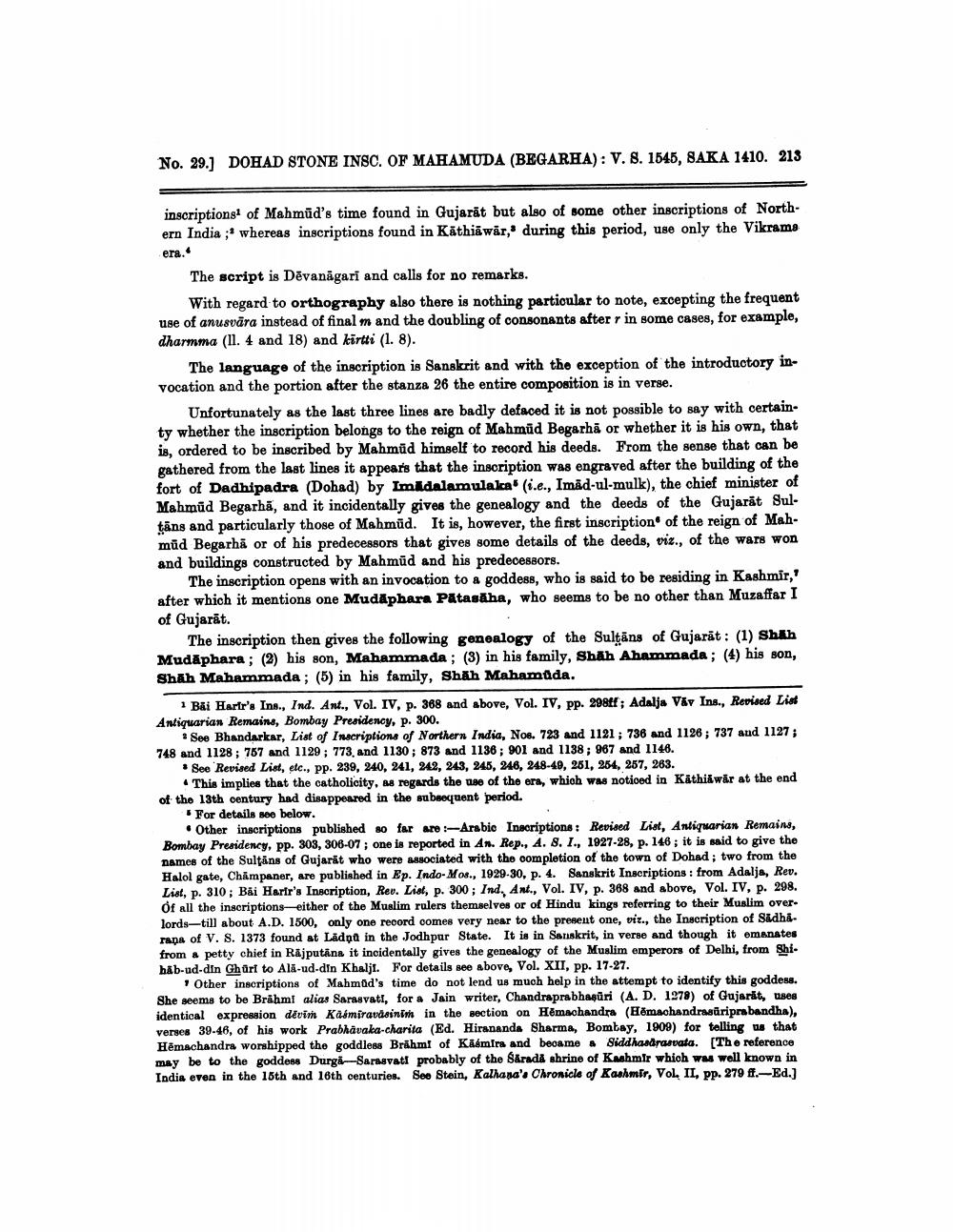________________
No. 29.) DOHAD STONE INSC. OF MAHAMUDA (BEGARHA): V. 8. 1545, SAKA 1410. 213
inscriptions of Mahmud's time found in Gujarāt but also of some other inscriptions of Northern India ;' whereas inscriptions found in Käthiāwār, during this period, use only the Vikrama
era.
The script is Dēvanagari and calls for no remarks.
With regard to orthography also there is nothing particular to note, excepting the frequent use of anusvāra instead of final m and the doubling of consonants after r in some cases, for example, dharmma (11. 4 and 18) and kirtti (1. 8).
The language of the inscription is Sanskrit and with the exception of the introductory invocation and the portion after the stanza 26 the entire composition is in verse.
Unfortunately as the last three lines are badly defaced it is not possible to say with certain ty whether the inscription belongs to the reign of Mahmud Begarhā or whether it is his own, that is, ordered to be inscribed by Mahmud himself to record his deeds. From the sense that can be gathered from the last lines it appears that the inscription was engraved after the building of the fort of Dadhipadra (Dohad) by Imidalamulaka. (i.e., Imad-ul-mulk), the chief minister of Mahmud Begarhā, and it incidentally gives the genealogy and the deeds of the Gujarat Sultäns and particularly those of Mahmūd. It is, however, the first inscription of the reign of Mahmūd Begarhā or of his predecessors that gives some details of the deeds, viz., of the wars won and buildings constructed by Mahmūd and his predecessors.
The inscription opens with an invocation to a goddess, who is said to be residing in Kashmir,' after which it mentions one Mudāphara Patasāha, who seems to be no other than Muzaffar I of Gujarāt.
The inscription then gives the following genealogy of the Sultans of Gujarät: (1) Shih Mudāphara ; (2) his son, Mahammada; (3) in his family, Shah Ahammada; (4) his son, Shah Mahammada; (5) in his family, Shah Mahamtda.
Bai Harir's Ins., Ind. Ant., Vol. IV, p. 368 and above, Vol. IV, PP. 2984f; Adalja Väv Ins., Revised List Antiquarian Remains, Bombay Presidency, p. 300.
* See Bhandarkar, List of Inscriptions of Northern India, Nos. 723 and 1121; 738 and 1126 ; 737 and 1127 748 and 1128 ; 767 and 1129; 773 and 1130 ; 873 and 1136 ; 901 and 1138; 967 and 1146.
* See Revised List, etc., pp. 239, 240, 241, 242, 243, 245, 246, 248-49, 251, 254, 257, 263.
This implies that the catholicityas regards the use of the era, which was noticed in Käthi.wär at the end of the 13th century had disappeared in the subnequent period.
For details see below
• Other inscriptions published 80 far are - Arabic Inscriptions: Revised List, Antiquarian Remains, Bombay Presidency, pp. 303, 306-07 ; one is reported in An. Rep., A. 8. I., 1927-28, p. 146; it is said to give the names of the Sultans of Gujarat who were associated with the completion of the town of Dohad; two from the Halol gate, Champaner, are published in Ep. Indo-Mos., 1929-30, p. 4. Sanskrit Inscriptions : from Adalje, Rev. List, p. 310; Bai Harir's Inscription, Rev. List, p. 300; Ind. Ant., Vol. IV, p. 368 and above, Vol. IV, p. 298. Of all the inscriptions-either of the Muslim rulers themselves or of Hindu kings referring to their Muslim over. lords—till about A.D. 1500, only one record comes very near to the present one, viz., the Inscription of Sadha. rana of V. S. 1373 found at Lädpt in the Jodhpur State. It is in Sanskrit, in verse and though it emanates from & petty chief in Rajputâna it incidentally gives the genealogy of the Muslim emperors of Delhi, from Shihåb-ud-din Ghurt to Ala-ud-din Khalji. For details see above, Vol. XII, pp. 17-27.
1 Other inscriptions of Mahmid's time do not lend us much help in the attempt to identify this goddess. She seems to be Brahmi alias Sarasvati, for a Jain writer, Chandraprabhagüri (A.D. 1278) of Gujarat, uses identical expression devin Kasmiravdoinith in the section on Hēmachandra (Homachandrasdriprabandha), verses 39-46, of his work Prabhavaka-charita (Ed. Hirananda Sharma, Bombay, 1909) for telling us that Hēmachandra worshipped the goddless Brahm of Káémirs and became a Siddhandraspata. [The reference may be to the goddess Durgi-Sarasvati probably of the Sarada shrine of Kashmir which was well known in India even in the 15th and 16th centuries. See Stein, Kalhana's Chronicle of Kashmir, Vol. II, pp. 279 ff.-Ed.)




